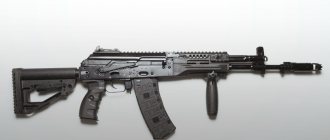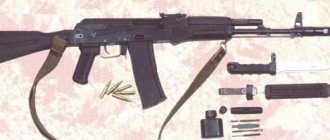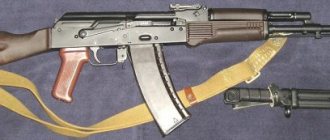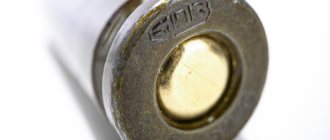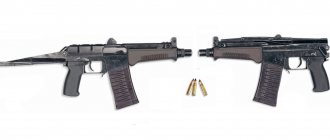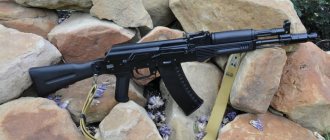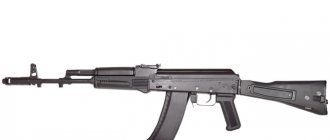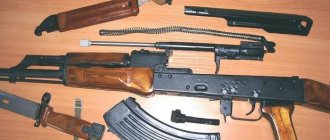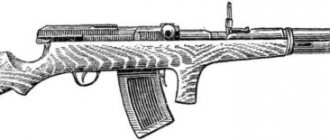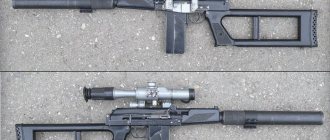The Kalashnikov assault rifle, created in the late forties, has gained immense popularity throughout the world. It has become one of the widely known symbols of Russia. Its popularity lasted for decades. However, time passes and the requirements for small arms are growing. The Kalashnikov Concern is constantly engaged in new developments that continue to delight experts. An important step was the creation of slot machines belonging to the hundredth series. They combine the modern technological level and traditional qualities that brought the Kalashnikov assault rifle worldwide fame.
Syrian security forces tested the latest version of the Kalashnikov assault rifle in battles
For a long time, the main types of small arms of the Syrian army and other security forces were various versions of the Kalashnikov assault rifle, manufactured in the USSR, China, and Eastern European countries, such as the Hungarian and Yugoslav clones of the famous AK-47. At the end of the 90s, the Syrians purchased a small batch of AK-74M assault rifles from Russia. However, when they arrived at the disposal of elite units, they, as they say, did not make any difference. At first, the Syrians had to resist the aggression of international terrorism with the AK-47, AKM and Type 56, proven during decades of operation.
Kalashnikov assault rifles of the “hundredth series” are... What are Kalashnikov assault rifles of the “hundredth series”?
AK101
(GRAU Index -
6P43
) and
AK103
(GRAU Index -
6P45
) - export versions of the AK74M assault rifle, distinguished by the use of 5.56x45 mm (SS109) and 7.62x39 mm (M43) cartridges, respectively. AK103 can use AK/AKM assault rifle magazines.
AK102
,
AK104
,
AK105
are modifications of the AK101, AK103 and AK74M, respectively, with a barrel shortened by 101 mm.
The intermediate (between the AK74M and AKS74U) barrel length made it possible to reduce the dimensions of the weapon, leaving the gas chamber in the same place relative to the breech end of the barrel as in the AK74M, and not moving it back (as in the AKS74U). This increased the unification of the entire “hundredth” family.
AK101, AK102, AK103 and AK104 are intended for export sale, and AK105 - firing 5.45x39 cartridges like the AK74M - for the Russian armed forces and law enforcement agencies.
The butt and fore-end of the new assault rifles are made of impact-resistant glass-filled polyamide in black color.
Metal parts are also protected from corrosion by a special coating. Shortened machine guns are equipped with a modified aiming bar (marking only up to 500 m).
All variants have seats for installing an under-barrel grenade launcher or bayonet. The delivery set includes: an oiler, a belt for carrying weapons and accessories.
General Director of Izhevsk Machine-Building Plant OJSC V.P. Gorodetsky spoke about the “hundredth series” as follows:
| The “hundredth” series contains new materials, new technologies, new design solutions, and firing characteristics are much higher than those of the AKM, which our army is armed with today. We supply only the “hundredth” series to other countries. |
In 2009, it was announced the development of a new model that would replace the “100th series” AK.
Options
| AK-101 |
| AK-102 |
| AK-103 |
| AK-103 disassembled. Image by Nikita Kashcheev |
| AK-105 |
- AK101-1, AK102-1, AK103-1, AK104-1, AK105-1 - with a simplified firing mechanism (without a retarder and self-timer with an axis), allowing you to fire only single shots. Designed for law enforcement agencies and security structures.
- AK101-2, AK102-2, AK103-2, AK104-2, AK105-2 - variants with a modified firing mechanism that allows firing with a burst of 3 shots. Accordingly, the switch has 4 positions: P - safety, A - automatic firing, 3 - firing with a burst cut-off of 3 shots, 1 - firing with single shots.
- AK103-3 is an updated version with an ergonomically shaped pistol grip with an additional safety button, Picatinny rails on the receiver and lower part of the forearm, and a removable bipod (which also serves as the front handle).
The new series still does not use lightweight alloys to reduce weight. Under the barrel there is a non-folding ramrod rod, which has a place in the stock or pouch when folded together with accessories.
Geography of application
Venezuela
:
In 2006, Venezuela entered into a contract for the supply and licensed assembly of 100 thousand AK-103 assault rifles, 74 million rounds of 7.62×39 mm caliber, magazines, bayonets, spare parts, technical manuals and 5 simulators and the construction of factories for the production of cartridges for them with a total cost of about $40 million.
Construction of the plants will be completed in 2012. This contract has become the largest for Izhmash over the past 25 years. In addition, according to the country's President Hugo Chavez, Venezuela is ready to purchase another 920 thousand machine guns.
The main reason for increasing arms purchases is the threat of an American military invasion.
It is assumed that the Russian assault rifles will replace the Belgian FN FAL automatic rifles and Israeli Uzi submachine guns, which have been in service with the Venezuelan army for the last decades.
Russia
: On November 25, 2009, at a meeting with representatives of the republican and Russian media, the General Director of Izhevsk Machine-Building Plant OJSC Vladimir Pavlovich Gorodetsky said the following regarding the supply of the “hundredth series” to the Russian army:
| Since about 1997-98, we have been developing our small arms only on an initiative basis. We have neither large orders nor tactical and technical characteristics from the army. We create weapons and then offer them to our army. After appropriate tests, she adopts it. This was the case with the “hundredth” series machines. I went to the deputy minister for six months so that he could endorse the resolution for adoption. Now all over the world they buy only the “hundredth” series. |
Indonesia
: 9 thousand Kalashnikov AK-102 assault rifles have been ordered.
Disassembling the machine
The design of the machine gun is practically no different from the AK-74. Disassembly and assembly occur in the same way. It may be necessary to perform partial or complete disassembly. In the first case, this is done for visual inspection, repair, cleaning or lubrication. Complete disassembly may be required if there is significant contamination or for repairs.
In most cases, incomplete disassembly is used. Before you start, you need to set aside a place for it. If this happens in camping conditions, then for this you need to spread a piece of cloth on which the parts will be laid out. They are arranged in order of extraction. When assembling, you need to pay attention to the numbers. This is necessary to ensure that someone else’s part is not accidentally installed in the machine.
Partial disassembly is performed as follows:
- First you need to remove the magazine. To do this, take it with your right hand and press the lever from behind with your thumb. At this time, the forend is held with the left hand.
- You need to make sure that there is no cartridge in the chamber. To do this, an inspection is done. For it, the switch is set to the position for single or automatic fire. The bolt handle is pulled back. After inspecting the chamber, they make sure that there is no cartridge there. Release the shutter. Then a control descent is performed, while pointing the weapon to the side.
- A pencil case with accessories is removed from the butt. To do this, press it with your finger so that it springs back and comes out. You need to open the pencil case and remove the accessories from it: a punch, a wiper, a brush and a screwdriver.
- The cleaning rod is separated. To do this, its front end is tilted to the side. When it is released, the ramrod is pulled forward.
- Disconnect the muzzle brake-compensator. To do this, you must first press the latch in with a screwdriver. After this, the compensator is unscrewed. It must be rotated counterclockwise.
- The receiver cover is separated. To do this, grab the neck of the butt with the left river, pressing the protrusion from behind with your thumb. The receiver is removed with the right hand in an upward direction.
- Remove the return mechanism. With your left hand you push it forward as far as it will go. After the heel leaves the socket, it is lifted up and slightly back.
- Take out the bolt frame along with the bolt. To do this, move it back and take it out. The latter is separated and placed separately.
- Disconnect the gas tube with the barrel lining. To do this, the pencil case is put on the protrusion of the lock and turned away from you to a vertical position. After this, the gas tube can be freely removed.
This complete disassembly is complete. Now perform the necessary actions (cleaning, lubricating or others), and then begin assembly. To do this you need to do the following:
- First, the gas tube with the barrel lining is installed in its original place.
- The bolt is connected to the bolt frame. They are then inserted into the receiver.
- Install the return spring.
- Reinstall the receiver cover.
- The trigger must be uncocked and the safety on.
- The muzzle brake-compensator is placed in its original place.
- Place the cleaning rod in place and secure it.
- The pencil case is inserted into the butt in its original place.
- The magazine is inserted into the machine.
The machine gun is now assembled and ready to fire. Disassembly and assembly of weapons of the 100th series for all models is performed in the same way. It should be borne in mind that this procedure should not be used too often, as it contributes to accelerated wear of parts.
AK-101
Photo of AK-101
The difference from the AK-74M is only in the cartridge used - the AK-101 uses 5.56x45 mm ammunition, used in NATO small arms. Other differences follow from this. This machine gun has a different barrel with a chamber (a different rifling pitch for a longer and heavier 5.56 mm bullet, the barrel caliber is slightly larger, the chamber is longer, since the 5.56x45 cartridge case is 6 mm longer than the domestic one and has a different shape), the AK-101 has a different bolt (since the 5.56 mm cartridge has a different diameter of the case bottom, the thickness of the bottom and the dimensions of the groove for engaging the bolt are different). The gas release mechanism has also been changed, since the 5.56x45 mm ammunition has significantly greater power compared to the 5.45x39 cartridge, which is why the bolt frame receives a greater impulse from the shot, all other things being equal. Therefore, for the stability of the weapon’s combat and the rate of firing in bursts, the conditions were changed, and the frame rolls back with an impulse close in magnitude to the rollback impulse of the AK-74M frame. The accuracy of the AK-101 is noticeably higher than the accuracy of the AK-74M, the reason for which is the 5.56x45 cartridge.
Photo of AK-101
The total length of the machine gun with the stock unfolded is 934 mm, and if the stock is folded, the length of the weapon is 705 mm. The AK-101 weighs 3.6 kg with an empty magazine, and 4 kg when fully loaded. The barrel length of the AK-101 is the same as on the base version - 415 mm. A 5.56 mm caliber bullet flies out of the AK-101 barrel at a speed of 910 m/s. The automatic retarder ensures a rate of fire of no more than 600 rounds per minute. The rear sight of this machine gun is adjustable, like the AK-74M, the fixed positions of the rear sight in height range from 1 to 10 in increments of one, which corresponds to values from 100 to 1000 meters in increments of 100 meters.
The main visual difference between the AK-101 and the AK-74M is the shape of the magazine. The bend of the AK-101 magazine is significantly less than the bend of the AK-74M magazine.
Technical characteristics of AK-103
- Caliber: 7.62×39
- Weapon length: 943/700 mm
- Barrel length: 415 mm
- Weight without cartridges: 3.4 kg.
- Rate of fire: 600 rounds/min
- Magazine capacity: 30 rounds
Assault rifles
- Austria
- Brazil
- Czech
- South Korea
- South Africa
- France
- USA
- Singapore
- Spain
- Russia/USSR
- Australia
- Finland
- Germany
- Türkiye
- Switzerland
- Denmark
- Japan
- Israel
- Sweden
- Indonesia
- Belgium
- Poland
- Ukraine
- Italy
- Croatia
- Iran
- Dominican Republic
- Mexico
- Serbia
- Argentina
- China
- Canada
- Taiwan
- Great Britain
Related:
Technical description and operating instructions The technical description and operating instructions contain technical data, a description of the operating principle and device, as well as information…
Technical description and operating instructions introductionThe technical description and operating instructions for “Flexible tape heating elements Engl-1” are intended for information…
Technical description and operating instructions for the firmware used V 2 This technical description and operating instructions (hereinafter) are intended for study and proper operation…
Technical description, operating instructions This technical description and operating instructions are guidelines for the operation, transportation and storage of the substation...
Technical description and operating instructions. IntroductionThe technical description and operating instructions (OI) are intended for the study and proper operation of test benches…
I. technical description This technical description and operating instructions contain technical data, a description of the operating principle and design...
Technical description and operating instructions p. Gigant 2006 Before operating the product, read the technical description and operating instructions for the machines included in the unit
Technical description, operating instructions, catalog of main assembly units
Attention: Before you start working on the baler, read the technical description and operating instructions
Technical description, operating instructions, catalog of main assembly units. Attention: Before you start working on the baler, read the technical description and operating instructions
Technical description and operating instructions 2S9 then Moscow a These Technical Descriptions and Operating Instructions are a guide for the study and operation of a 120-mm self-propelled…
Technical description and operating instructions for NNPM
468264. 002TOThis technical description is intended for studying the set of automation equipment and is a mandatory guide...
Technical description and operating instructions 2005 contents introduction 3 This technical description and operating instructions apply to the TPE-400/400-460-1 series rectifier with a power of 185…
Technical description This technical description (hereinafter) and operating instructions (hereinafter ie) are intended for studying the device and operating rules...
Technical description and operating instructions m 278. 006 That 1 introduction This manual contains a description of the tachometer design, operating principle, as well as technical characteristics and information necessary…
Russian Federation JSC “Enterprise in 1336” current splitter TR-01 This technical description, operating instructions, passport provide a brief description of the design of the current splitter...
Technical description and operating instructions The operating instructions are intended to familiarize you with the device, operating principle and basic rules for operating the sensor...
Manual, instructions for use
Instructions, instructions for use
The National Guard will be armed with a modernized AK-74M
The effectiveness of the modified Kalashnikov is one and a half times higher than that of the basic model
National Guard servicemen will receive upgraded AK-74M assault rifles of the Mikhail Kalashnikov system. As Ruslan Pukhov, executive director of the Union of Gunsmiths of Russia, told Izvestia, special modernization kits developed by the Kalashnikov concern make it possible to increase the effectiveness of combat use of weapons by 1.5 times according to the criterion of “kill frequency” at a range of up to 300 m. Until the appearance of new machine guns in the troops AEK-971 and AK-12, AK-74M will be the main small arms of the country's security forces.
History of development
Mikhail Kalashnikov never graduated from a higher educational institution. The degree of Doctor of Technical Sciences was awarded to him based on the totality of his merits, without defending a dissertation.
Kalashnikov invented his combat machine gun, depicted on the state emblems of Zimbabwe, Mozambique and East Timor, in 1947. In 1949, the machine gun was adopted, and it began its triumphal march across the continents.
Kalashnikov AK-47 assault rifle.
1949 The machine was trouble-free. He could have been in water, in mud, in sand, in fire, but he continued to shoot.
Over the long years of production, several generations of the machine have changed.
The first generation includes two models. These are AK (or AK-47) - the basic version and AKS - the version for paratroopers. The AKS stock, in the form of a metal frame on hinges, folds down under the forend. The butt of the AK is noticeably bent down. The stop point lies well below the shooting line. This increases vertical dispersion when firing in bursts. The butt, handle and fore-end are wooden.
The machine gun is designed for a 7.62x39 mm cartridge. The geometric shape of the cartridge determines the rather steep bend of the magazine.
The assault rifle had already gained fame when, in the mid-fifties, Tula gunsmiths proposed an alternative - the TKB-517 model designed by G. Korobov. In 1958, the Ministry of Defense held a competition to develop a new machine gun, and on its basis it was also necessary to develop a machine gun unified with it. Mikhail Kalashnikov won this competition. AKM - modernized AK, a representative of the second generation of Kalashnikov assault rifles, entered the army in 1959.
The downward bend of the buttstock was changed so that the resting point lay on the continuation of the shooting line. The machine has become more reliable and lighter. The sighting range increased to 1000 m. A barrel compensator appeared, this improved accuracy.
The same generation includes AKMS assault rifles with a folding stock and AKMN with a night sight.
In 1974, the USSR army, following NATO, switched to a low-pulse cartridge of a smaller caliber. Kalashnikov also adapted his assault rifle to this 5.45x39 mm cartridge. The new third generation assault rifle was called AK-74. Since the smaller caliber cartridge is one third lighter than its predecessor, it has become possible to increase the number of cartridges in wearable ammunition by one and a half times.
Mikhail Timofeevich Kalashnikov - twice Hero of Socialist Labor, Hero of Russia
The debate about the advantages and disadvantages of this or that cartridge has not subsided to this day. In any case, the AK-74 has retained high commonality with the AKM. The third generation also includes the shortened AK-74U, folding night AKS-74N and the top of the line AK-74M with Picatinny rail.
Assault rifle model (LCT) TK104 M4 MOD (NV) – Airsoft Store
| Type of drive: | AEG |
| Case material: | Metal, ABS plastic |
| Gearbox type: | ver. 3 |
| Battery connector: | Mini |
| Battery type: | AK-type |
| Departure speed: | 120-130 m/s |
| Rate of fire: | 700-800 sh./min. |
| Weight without box: | 3540 gr. |
| Overall length/with stock folded: | 880/800 mm. |
| Store included: | Mechanical (for 130 balls) |
| Manufacturer country: | Taiwan |
Driven for airsoft games from the LCT company, the TK104 M4 MOD model is a highly realistic copy of the AK-104 assault rifle - it is a shortened version of the AK-103 assault rifle, and it is also distinguished by the presence of a flash suppressor, a tactical forend and a telescopic butt from the M-series carbines.
Manufacturing materials
The pistol grip, forend, RIS rails and stock are made of high quality plastic. The receiver and its cover, fire switch, shutter curtain and handle, flash suppressor, standard sights (front sight, rear sight), swivels and dovetail mount are metal.
- Performance characteristics (TTX)
- The TK104 M4 MOD drive weighs ~3.5 kg and is 880 mm long (800 mm when the stock is folded).
- Gearbox version 3 allows you to reach airsoft ball launch speeds of up to 130 m/s and a rate of fire of up to 800 balls per minute.
- Other characteristics
The telescopic stock allows you to quickly and easily adjust the required length for maximum shoulder rest comfort and increased shooting accuracy. RIS strips on the forend are used for mounting a tactical handle, optical sight, flashlight, etc. on the drive.
The battery is installed under the receiver cover. The drive comes with a mechanical magazine (for 130 balls). The fire switch allows you to fire both in single mode and in bursts.
Equipment:
- Airsoft machine LCT TK104 M4 MOD (NV);
- Mechanical magazine for 130 balls.
Important! All components/add-ons (listed in the table, column “Contents/add-ons”) that come with the airsoft weapon model are supplied free of charge (as a gift). When placing an order, if desired, you can choose which add-ons you need
When ordering, components/add-ons not listed in the add-on selection window will be removed from the box!
Muzzle energy – less than 3 J
Advantages and disadvantages
Advantages and disadvantages
High reliability.
Use of modern technologies.
High rate of fire.
The use of precision casting in the production of these weapons.
Low accuracy of fire.
Average sighting range.
A Picatinny rail is attached to the left side of the receiver. It allows you to install various sights, flashlights or other types of body kit. They can be easily put on or taken off, since this bar is a universal fastener.
There are a variety of models to choose from, from which you can always choose the one that suits you. The main varieties of the most common types of cartridges are used here.
A muzzle compensator of a special design is used. Its use makes it possible to improve accuracy when firing in bursts. In previous types of machines this was an additional option. Now all models of machines are equipped with such compensators.
In previous versions, folding stocks were riveted metal frames. During intensive use in field conditions, they quickly failed. Now plastic folding stocks are used instead. They are more reliable and much more convenient.
The technology for creating weapons has changed. Previously, we were talking about stamping, now precision casting is used. The technology now used ensures high precision when creating parts.
These assault rifles retain the advantages of the classic AK version. They are simple, reliable and trouble-free. Added to this is the use of advanced technologies. The disadvantages include insufficiently high accuracy of fire.
Operating countries
Geography of distribution of Kalashnikov assault rifles of the “hundredth series”.
- Armenia Armenia
- Venezuela Venezuela
- India
- Indonesia Indonesia
- Iran Iran
- Kazakhstan Kazakhstan
- Libya Libya
- Namibia Namibia
- Russia Russia: AK-105 has been adopted by private security forces and the Federal State Unitary Enterprise “Security” of the Ministry of Internal Affairs of the Russian Federation, as well as the Federal Penitentiary Service of the Russian Federation and the Federal Bailiff Service of the Russian Federation; AK-105, AK-104, AK-103 are in service with FSB units. On November 25, 2009, General Director of Izhevsk Machine-Building Plant OJSC V.P. Grodetsky said the following regarding deliveries of the “hundredth series” to the Russian army:
Since about 1997-98, we have been developing our small arms only on an initiative basis. We have neither large orders nor tactical and technical characteristics from the army. We create weapons and then offer them to our army. After appropriate tests, she adopts it. This was the case with the “hundredth” series machines. I went to the deputy minister for six months so that he could endorse the resolution for adoption. Now all over the world they buy only the “hundredth” series. - Saudi Arabia Saudi Arabia
- Syria Syria
- Uruguay Uruguay: The AK-101 is in service with Uruguayan peacekeepers.
- Fiji Fiji
Varieties
All products in the series are samples of individual weapons for personnel. It is striking that the parts that were wooden in the AK-74 are made of high-strength black plastic in the 100th series. The hundredth series is unofficially called “black Kalashnikov”.
AK-101
The lead model of the series, the AK-101, with which the series began, is chambered for the American 5.56x45 mm cartridge.
AK-101 assault rifle. Full length barrel
The butt of one hundred and one folds up. It folds differently than the AK-74 stock, not down, but to the left. You can shoot:
- with folded;
- with the butt folded down.
The product has a seat on which you can install an under-barrel grenade launcher or a bayonet.
The geometry of the NATO cartridge causes the magazine to bend less than in the case of the 7.62 mm cartridge.
AK-102
The second model in the series.
AK-102 assault rifle. The trunk is shortened by 10 cm
The AK-102 is a “small-sized” version of the AK-101. Its barrel was shortened by only 100 mm, which made it possible to maintain the location of the gas chamber as on the long-barreled model while maintaining the size of the piston.
Some gain in compactness in terms of weight and size parameters led to a decrease in the sighting range.
AK-103
New reincarnation of 7.62 mm caliber. The model is adapted for the Soviet cartridge 7.62x39 mm. This is the so-called “intermediate” cartridge of the 1943 model. It is called intermediate because it is larger than the cartridge used by Shpagin submachine guns (PPSh), but smaller than the cartridge of the Degtyarev infantry machine gun (DP). Many experts believe that it is the AK-103 model that has the greatest export potential due to the fact that the Soviet cartridge is more powerful than the NATO one, and the reserves of Soviet cartridges in the world are huge.
Structurally, the machine gun follows the AK-101.
AK-104
A small-sized version of the AK-103 shortened by 10 cm. A complete analogue of the AK-102, adapted for the old Soviet 7.62 mm cartridge. A short barrel results in shorter range. The design is exactly the same as the AK-102.
AK-105
The only model in this review that is intended not for export, but for the domestic market. The machine gun is used by the Ministry of Internal Affairs and the FSB. It shoots with domestic 5.45 mm cartridges. The plastic butt of the AK-105 tilts to the left, but not like a hinged frame, as was the case with the AKS-74U.
The hundredth line includes three more models, which are not the subject of detailed consideration in this review. These are models AK-107, 108, 109. The interesting thing about these models is that all three are equipped with a balanced automatic system.
The idea of balancing automation is to partially reduce recoil. The recoil of the machine consists of two components of different physical nature:
- Firstly, recoil is caused directly by the act of the bullet being fired. The bullet flies forward with acceleration, and the machine gun transmits an impulse through the butt to the shooter’s shoulder. This happens while the shutter is still locked;
- The second recoil pulse occurs when the bolt carrier, moving backward, reaches the limiter in the rearmost position. At this moment, the shooter receives a push in the shoulder.
There is another impulse - the third, but it is directed in the opposite direction. It occurs when the bolt carrier, moving forward, reaches the front stop at the end of the reloading cycle.
Balanced automation allows you to reduce the second and third recoil impulses. The bolt group is connected through a synchronizer to a “balancer”, the mass of which is the same as the mass of the bolt. A gear acts as a synchronizer, ensuring that the balancer moves at the same speed as the shutter, but in the opposite direction. It turns out that the total impulse of the balancer and the gate is always zero.
The bolt and balancer in their extreme positions hit each other, and not the stationary parts of the machine gun. In a machine gun without a balancer, an additional impulse is transmitted to the butt and shoulder of the shooter. And if there is a balancer, the impulse is extinguished. The recoil becomes less, the accuracy increases by 15 - 20%.
The AK-107 assault rifle is designed for the domestic 5.45 mm cartridge, the AK-108 for the NATO cartridge, and the AK-109 for the old Soviet 7.62 mm cartridge.
Export
Venezuela
In 2005, Venezuela entered into a contract for the supply of 100 thousand AK-103 assault rifles, 74 million rounds of 7.62×39 mm caliber, magazines, bayonets, spare parts, technical manuals and 5 simulators with a total value of about $40 million. In 2006, it was achieved an agreement on the construction by 2012 of factories for the licensed production of assault rifles and ammunition for them. In addition, the country's President Hugo Chavez announced his readiness to purchase another 920 thousand machine guns. Construction of the factories was suspended in 2014. Subsequently, the completion of construction of the plant was postponed to the end of 2015 due to a change in contractor. After a two-year pause, the construction of factories in Venezuela for the production of Kalashnikov assault rifles and ammunition will resume on April 1, the head of the Rosoboronexport delegation at the FIDAE-2016 arms exhibition, Sergei Ladygin, said in an interview with RIA Novosti. At the moment, the readiness of two enterprises - for the production of Kalashnikov assault rifles (AK-103) and ammunition for them - is about 70%. At one time, construction was suspended, including due to financial difficulties, as well as the work of the general contractor. Now the general contractor has changed, and according to the new plans, the plants will be completed in 2016-2017. In 2016, Rogozin said that the plant would begin production in 2022.
